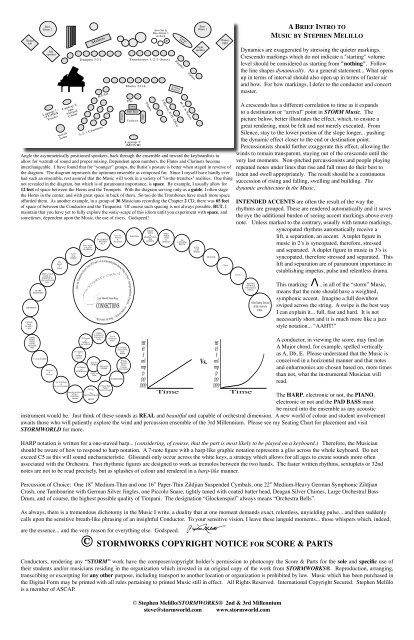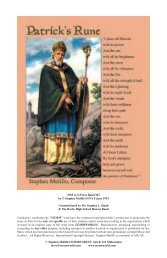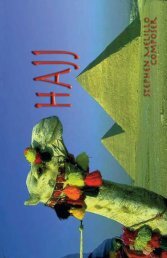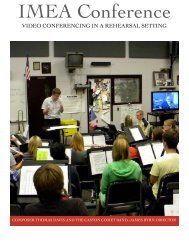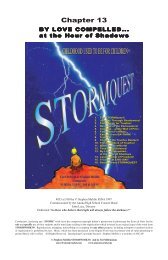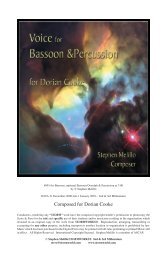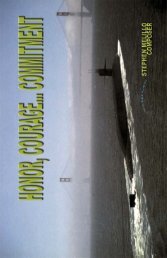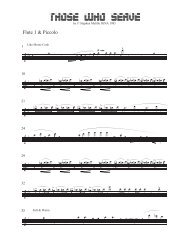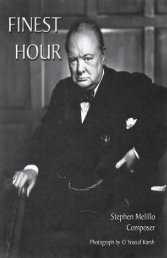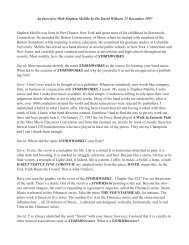Score - STORMWORLD
Score - STORMWORLD
Score - STORMWORLD
Create successful ePaper yourself
Turn your PDF publications into a flip-book with our unique Google optimized e-Paper software.
iTunes<br />
left<br />
GODSPEED!<br />
ESCAPE<br />
from<br />
PLATO’s<br />
CAVE<br />
AHAB!<br />
TEDDY<br />
ERICH<br />
DAVID<br />
MUSASHI<br />
HIM<br />
IN THE<br />
BEGINNING!<br />
“I” of the STORM<br />
Bass<br />
Drum 2<br />
left<br />
speaker<br />
Laptop 1:<br />
iTUNES<br />
Tracks<br />
TIME to TAKE<br />
BACK the<br />
KNIGHTS! &<br />
American Knights<br />
Suite<br />
The First<br />
&<br />
The Last<br />
Vocal<br />
Solo<br />
The<br />
Speech<br />
of<br />
Angels<br />
Art of the State<br />
&<br />
By Love Inviolate<br />
Laptop 2:<br />
opt.<br />
Virtual<br />
Choir<br />
WAIT<br />
of the<br />
WORLD<br />
Mallets<br />
Trumpets 3-2-1<br />
3-2-1 Clarinets<br />
...from the Timestorm of past, from 1975 and I-v-I on a basement piano during "Only for Now", through hundreds of pieces... to works yet to be... These are some of the...<br />
13 Chapters<br />
of<br />
STORM<br />
Journeys<br />
16 Chapters<br />
of<br />
STORMQuest<br />
America the Brave!<br />
STAR!<br />
GOD Bless<br />
America<br />
IN a CAUSE<br />
CALLED<br />
“GLORIOUS”<br />
15 Chapters<br />
of<br />
WISH to<br />
the WORLD<br />
After the<br />
STORM<br />
ONLY for<br />
NOW<br />
B.Clar<br />
CONNECTIONS<br />
S-Matrix<br />
Symphony II<br />
Concerto for<br />
Violin<br />
SON of the<br />
STORM<br />
O Come Holy<br />
Night!<br />
Giving!<br />
Festival of Light!<br />
The<br />
FOUNTAINHEAD<br />
ERICH!<br />
IN a SERVICE<br />
BEYOND<br />
SELF<br />
Trombones 1-2-3 (bass)<br />
Horns 2314<br />
Pic<br />
Amp<br />
PAD Bass<br />
A BRIEF INTRO TO<br />
MUSIC BY STEPHEN MELILLO<br />
Dynamics are exaggerated by stressing the quieter markings.<br />
Crescendo markings which do not indicate a "starting" volume<br />
level should be considered as starting from "nothing". Follow<br />
the line shapes dynamically. As a general statement... What opens<br />
up in terms of interval should also open up in terms of faster air<br />
and bow. For bow markings, I defer to the conductor and concert<br />
master.<br />
A crescendo has a different correlation to time as it expands<br />
to a destination or “arrival” point in STORM Music. The<br />
picture below, better illustrates the effect, which, to ensure a<br />
great rendering, must be felt and not merely executed. From<br />
Silence, stay to the lower portion of the slope longer... pushing<br />
the dynamic effect closer to the end or destination point.<br />
Percussionists should further exaggerate this effect, allowing the<br />
winds to remain transparent, staying out of the crescendo until the<br />
very last moments. Non-pitched percussionists and people playing<br />
repeated notes under lines that rise and fall must do their best to<br />
listen and swell appropriately. The result should be a continuous<br />
succession of rising and falling, swelling and building. The<br />
dynamic architecture is the Music.<br />
INTENDED ACCENTS are often the result of the way the<br />
rhythms are grouped. These are rendered automatically and it saves<br />
the eye the additional burden of seeing accent markings above every<br />
note. Unless marked to the contrary, usually with tenuto markings,<br />
syncopated rhythms automatically receive a<br />
lift, a separation, an accent. A tuplet figure in<br />
music in 2’s is syncopated, therefore, stressed<br />
and separated. A duplet figure in music in 3’s is<br />
syncopated, therefore stressed and separated. This<br />
lift and separation are of paramount importance in<br />
establishing impetus, pulse and relentless drama.<br />
This marking: , in all of the “storm” Music,<br />
means that the note should have a weighted,<br />
symphonic accent. Imagine a full downbow<br />
swiped across the string. A swipe is the best way<br />
I can explain it... full, fast and hard. It is not<br />
necessarily short and it is much more like a jazz<br />
style notation... “AAHT!”<br />
A conductor, in viewing the score, may find an<br />
A Major chord, for example, spelled vertically<br />
as A, Db, E. Please understand that the Music is<br />
conceived in a horizontal manner and that notes<br />
and enharmonics are chosen based on, more times<br />
than not, what the instrumental Musician will<br />
read.<br />
The HARP, electronic or not, the PIANO,<br />
electronic or not and the PAD BASS must<br />
be mixed into the ensemble as any acoustic<br />
instrument would be. Just think of these sounds as REAL and beautiful and capable of orchestral dimension. A new world of colour and student involvement<br />
awaits those who will patiently explore the wind and percussion ensemble of the 3rd Millennium. Please see my Seating Chart for placement and visit<br />
<strong>STORMWORLD</strong> for more.<br />
HARP notation is written for a one-staved harp... (considering, of course, that the part is most likely to be played on a keyboard.) Therefore, the Musician<br />
should be aware of how to respond to harp notation. A 7-note figure with a harp-like graphic notation represents a gliss across the whole keyboard. Do not<br />
exceed C5 as this will sound uncharacteristic. Glissandi only occur across the white keys, a strategy which allows for all ages to create sounds more often<br />
associated with the Orchestra. Fast rhythmic figures are designed to work as tremolos between the two hands. The faster written rhythms, sextuplets or 32nd<br />
notes are not to be read precisely, but as splashes of colour and rendered in a harp-like manner.<br />
Percussion of Choice: One 18” Medium-Thin and one 16” Paper-Thin Zildjian Suspended Cymbals, one 22” Medium-Heavy German Symphonic Zildjian<br />
Crash, one Tambourine with German Silver Jingles, one Piccolo Snare, tightly tuned with coated batter head, Deagan Silver Chimes, Large Orchestral Bass<br />
Drum, and of course, the highest possible quality of Timpani. The designation “Glockenspiel” always means “Orchestra Bells”.<br />
As always, there is a tremendous dichotomy in the Music I write, a duality that at one moment demands exact, relentless, unyielding pulse... and then suddenly<br />
calls upon the sensitive breath-like phrasing of an insightful Conductor. To your sensitive vision, I leave these languid moments... those whispers which, indeed,<br />
∕¤‹›<br />
© STORMWORKS COPYRIGHT NOTICE FOR SCORE & PARTS<br />
are the essence... and the very reason for everything else. Godspeed.<br />
Jazz &<br />
Orchestral<br />
Music<br />
Voices<br />
Voice for<br />
Bassoon<br />
&<br />
Percussion<br />
11 Original<br />
Shows for the<br />
Field<br />
WPIM<br />
STORMWORKS<br />
Without<br />
Warning<br />
Honor,<br />
Courage<br />
Commitment<br />
Conductor<br />
Laptop 3:<br />
iMOVIE<br />
KOLDOON<br />
Harp<br />
Flutes<br />
fff<br />
ff<br />
f<br />
mf<br />
mp<br />
p<br />
pp<br />
ppp<br />
FINEST<br />
HOUR<br />
&<br />
RENDEZVOUS<br />
With<br />
DESTINY<br />
Also Set &<br />
Bass Drum 3<br />
on Kick<br />
Contra<br />
Basses<br />
2 Bassn, E.H, Oboe<br />
ONCE<br />
MORE<br />
UNTO<br />
the<br />
BREACH!<br />
Large<br />
Tam<br />
Eupho<br />
Time<br />
B-T-A Saxes<br />
Tubas<br />
Bass<br />
Drum 1<br />
right<br />
speaker<br />
Angle the asymmetrically positioned speakers, back through the ensemble and toward the keyboardists to<br />
allow for warmth of sound and proper mixing. Dependent upon numbers, the Flutes and Clarinets become<br />
interchangeable. I have found that for “younger” groups, the flutist’s posture is better when staged in reverse of<br />
the diagram. The diagram represents the optimum ensemble as composed for. Since I myself have hardly ever<br />
had such an ensemble, rest assured that the Music will work in a variety of "in-the-trenches" realities. One thing<br />
not revealed in the diagram, but which is of paramount importance, is space. By example, I usually allow for<br />
12 feet of space between the Horns and the Trumpets. With the diagram serving only as a guide, I often stage<br />
the Horns in the center, and with great space in back of them. So too do the Trombones have much more space<br />
afforded them. As another example, in a group of 36 Musicians recording the Chapter 2 CD, there was 65 feet<br />
of space of between the Conductor and the Timpanist. Of course such spacing is not always possible, BUT, I<br />
maintain that you have yet to fully explore the sonic-scape of this idiom until you experiment with space, and<br />
sometimes, dependent upon the Music, the use of risers. Godspeed!<br />
<br />
The<br />
UNIVERSE<br />
BELOW<br />
A<br />
WALK<br />
on the<br />
WATER<br />
Vs.<br />
MUSASHI<br />
fff<br />
ff<br />
f<br />
mf<br />
mp<br />
p<br />
pp<br />
ppp<br />
iTunes<br />
right<br />
CUBA<br />
J I D A I<br />
BEYOND<br />
COURAGE<br />
A Documentary<br />
in Music<br />
Time<br />
Conductors, rendering any “STORM” work have the composer/copyright holder’s permission to photocopy the <strong>Score</strong> & Parts for the sole and specific use of<br />
their students and/or musicians residing in the organization which invested in an original copy of the work from STORMWORKS®. Reproduction, arranging,<br />
transcribing or excerpting for any other purpose, including transport to another location or organization is prohibited by law. Music which has been purchased in<br />
the Digital Form may be printed with all rules pertaining to printed Music still in effect. All Rights Reserved. International Copyright Secured. Stephen Melillo<br />
is a member of ASCAP.<br />
All the Teaching Tools and<br />
all that is soon to be<br />
written...<br />
© Stephen Melillo/STORMWORKS® 2nd & 3rd Millennium<br />
steve@stormworld.com www.stormworld.com


